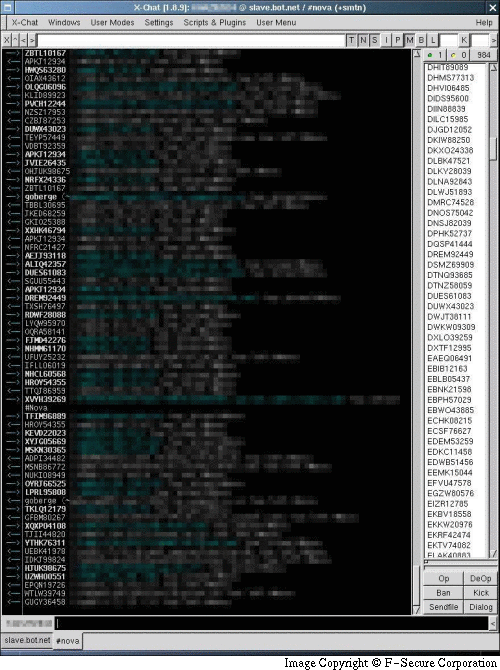Novabot
Summary
UPDATE ON 23RD OF JANUARY 2003
We have been monitoring the IRC network created by Novabot. During last 10 hours of 22nd of January, we saw close to 3000 bots from different IP addresses joining the attack network (although no more than 1000 of them can be accessible at a time as the IRC server has a thousand user limit). Around 21:00 GMT the IP address of the IRC server changed to 0.0.0.0 - making the server inaccessible. Before this we witnessed a person actively sending commands to the bots over the IRC channel. We will continue to monitor the situation.
Removal
Based on the settings of your F-Secure security product, it will either move the file to the quarantine where it cannot spread or cause harm, or remove it.
A False Positive is when a file is incorrectly detected as harmful, usually because its code or behavior resembles known harmful programs. A False Positive will usually be fixed in a subsequent database update without any action needed on your part. If you wish, you may also:
-
Check for the latest database updates
First check if your F-Secure security program is using the latest updates, then try scanning the file again.
-
Submit a sample
After checking, if you still believe the file is incorrectly detected, you can submit a sample of it for re-analysis.
Note: If the file was moved to quarantine, you need to collect the file from quarantine before you can submit it.
-
Exclude a file from further scanning
If you are certain that the file is safe and want to continue using it, you can exclude it from further scanning by the F-Secure security product.
Note: You need administrative rights to change the settings.
Technical Details
The IRC backdoor allows remote control of the system via a IRC channel. Upon request, the IRC part can be asked to scan a block of IP addresses from an infected machine. The scanning attempts to connect each IP addess using a predefined list of username and password combinations as follows:
Username Password Administrator empty Administrator admin Administrator administrator root root admin admin administrator test test test administrator test123 administrator temp administrator pass administrator password administrator changeme
If authentication passes, the "files.exe" is executed on the remote machine thus infecting it.
The "files.exe" is a setup package, that installs the backdoor to "C:\winnt\INF\other" and runs "taskmngr.exe" which is a repacked mIRC client. The mIRC client will then run "nt32.ini" instead of standard "script.ini" used by mIRC client.
After that the backdoor connects to the IRC server and joins the predefined channel. It generates a random nickname for each infected machine (consisting of four characters and five digits). It sets itself to start on the reboot via registry by adding the following key:
HKEY_LOCAL_MACHINE\Software\Microsoft\Windows\CurrentVersion\Run\Run32dll
Then the backdoor waits for commands. These commands include ability to download and execute programs.

To operate the backdoor uses set of scripts and binary files, as follows:
hide.exe Tool used to hide application mdm.exe Tool used to hide application psexec.exe Remote execution tool taskmgr.exe Repacked mIRC client backup.bat Batch script that attempts to infect remote host nt32.ini Main mIRC script remote.ini mIRC script that connects the server seced.bat Batch file start.bat Copies the "files.exe" from the Windows system32 directory to "C:\winnt\INF\other" win32.mrc mIRC script
F-Secure Anti-Virus detects this backdoor with the current updates.